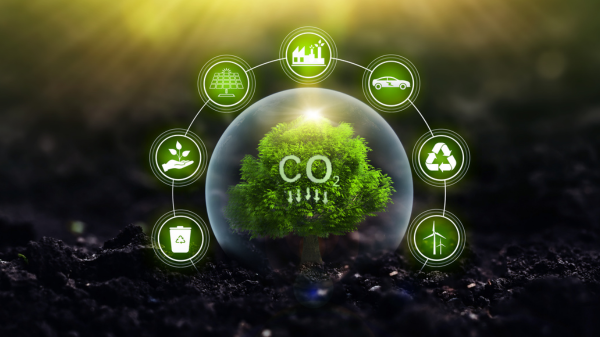Advance reports of a new UN Intergovernmental Panel on Climate Change (IPCC) study indicate bad news for those who believe humans are causing dangerous climate change and international cooperative agreements are necessary to prevent it. Reporting on the study, The Hill writes, “Governments across the globe are ‘nowhere near on track’ to meet their goal of preventing global warming of more than 1.5 degrees Celsius higher than the pre-industrial period.”
Only a massive, worldwide transformation of electric power, transportation, and agricultural systems can prevent temperatures from rising the 2 degrees Celsius or less which nations committed to in the Paris climate agreement, the report states.
Commenting on the report, Norway’s Environment Minister, Ola Elvestuen, said, “We are moving way too slowly. We have to do more of everything, faster. To reach the goals of the Paris agreement, we need large structural changes.”
The problem is governments are having a hard time convincing people the radical restrictions on fossil fuels and fundamental changes to their economies necessary to meet the Paris climate commitments—which IPCC’s own calculations show are insufficient to prevent the targeted temperature rise—are worth the minimal climate change benefits likely (or more likely, unlikely) to flow from the sacrifices they will be forced to make in terms of lower standards of living.
Even the minimal actions taken or proposed by governments so far carry a steep price tag.
In 2016 and again in 2018, for example, the U.S. House of Representatives adopted resolutions rejecting a tax on carbon dioxide emissions based on research showing a tax of as little as $28 per ton would result in decreased economic activity, eliminate up to 21 million job equivalents over the next four decades, and reduce workers’ wages as much as 8.5 percent. A separate study indicates a carbon tax of $37 per ton would lead to a loss of more than $2.5 trillion in aggregate U.S. gross domestic product by 2030—more than $21,000 in income loss per family—and cost more than 500,000 jobs in manufacturing and more than one million jobs overall by 2030.
Canada’s Financial Post reports Prime Minister Justin Trudeau’s $50 per ton carbon tax will cost households in Nova Scotia $1,120 per year and those in Alberta $1,111 per year, in the provinces facing the highest energy price increase from the tax. Even in Quebec and Manitoba, the two provinces where energy prices will increase the least as a result of the tax, households will still pay $662 and $683 more, respectively, per year for their electric power.
The news gets worse for Canadians. The Financial Post reports many experts say to reduce carbon dioxide emissions sufficient to avert catastrophe, carbon-dioxide emission taxes must increase to as high as $100 per ton or more. Under such a scenario, “households in Alberta will pony up $2,223, in Saskatchewan they’ll pay $2,065 and in Nova Scotia, $2,240. In fact, at $100 a ton, the average price for households in all provinces is well north of $1,000 per year,” the Financial Post reports.
In response to rising energy prices, the premiers of four of Canada’s provinces have decided to scrap the provincial taxes, programs, and fees imposed to implement Trudeau’s carbon tax.
All of this arrives as new research indicates the price of carbon dioxide must be much higher than at present to prevent the purported climate catastrophe. A report by IHS Markit reports the average price per ton of carbon emissions in G20 nations that have established a carbon trading market to reduce emissions is just $16 per metric ton, whereas the price needed to meet the minimal targets of the Paris climate agreement is closer to $80 per ton. Vox cites research indicating even a $50 per ton carbon tax in the United States would be too low to reduce carbon dioxide emissions 80 percent below 2005 levels by 2050 as the Obama administration had advocated. The Rhodium Group estimates to reach “80 percent (or more appropriately, 100 percent) reductions, carbon prices would likely need to exceed $100/ton by mid-century.”
Politicians faced with expulsion by voters unwilling to pay higher energy prices for less reliable energy are proving increasingly unwilling to impose the high price on carbon they say is necessary to avert a climate catastrophe. Leaders in Australia, Brazil, and Canada are publicly disavowing their commitments to reduce carbon dioxide emissions while remaining unwilling to pull out of the Paris climate agreement explicitly as the United States has done. In China, Europe, and Japan, leaders publicly proclaim their fealty to the agreement while missing midterm emission reduction goals, quietly approving new coal and natural gas power plants, and selling more vehicles powered by fossil fuels.
I have good news. The best evidence indicates humans aren’t causing a climate apocalypse. That means Paris’s failure is okay, even desirable, because abandoning it will mean more abundant energy for all.
- H. Sterling Burnett
SOURCES: The Hill; IHS Markit; Anti-Carbon Tax Coalition 2018; Anti-Carbon Tax Coalition 2016; Financial Post; Vox
IN THIS ISSUE …
Climate models overstate warming … India’s economy growing via coal … Global greening confirmed
CLIMATE MODELS OVERSTATE WARMING
A new paper in the journal Earth and Space Science, by climate scientists John Christy, Ph.D. and Judith Curry, Ph.D., shows climate models have fundamental weaknesses that make them invalid. For a climate model (or any other complex scientific model) to be valid and useful for description of phenomena and predictions of future changes, its fundamental hypotheses must be testable. As Christy and Curry write, “there must be at least one major component that, in principle, were it to be falsified, would call into question such an essential component of the model structure that you couldn’t simply remove it without changing the overall model type.”
Christy and Curry propose four criteria climate models should meet in order to be valid:
- Measurability: The target must be well-measured over a long interval.
- Specificity: The phenomenon must reliably emerge in all models on a known time scale.
- Independence: The target of the prediction must not be an input to the empirical tuning of the model.
- Uniqueness: The causality behind the observed change should be uniquely tied to the measured phenomenon.
Temperature trends in the tropical mid-troposphere meet all of these criteria. Consistent, unbiased, weather balloon radiosonde records for the tropical troposphere have been measured for more than 60 years, “long enough to identify relevant trends without undue influence of short-term events arising from internal variability or volcanic activity.” All 102 coupled climate model runs project on average of 2 degrees Celsius or more warming should have happened by now, meaning all models predict one specific thing on a specific timetable; and the Intergovernmental Panel on Climate Change states only “greenhouse forcing would explain a strong historical warming trend in the target region. The presence of such a trend would thus have only one explanation; likewise, its absence would conflict with only one major hypothesis of the model, namely the set of parameterizations that yield amplified GHG-induced warming,” Christy and Curry write.
Examining the annual tropical, mid-troposphere weather balloon temperature records from 1958 through 2017, Christy and Curry found all 102 model trends exceed the measured temperature trend, meaning they project more warming (87 of them statistically significantly more warming) than has actually been experienced in the region.
As a result, Christy and Curry conclude, climate models have a structural bias toward warming “at a sufficiently strong rate as to reject the hypothesis that the models are realistic.”
If models’ temperature projections—the most fundamental of their projections—can’t be trusted, neither can their other predictions.
SOURCES: Climate Etc; Earth and Space Science
INDIA’S ECONOMY GROWING VIA COAL
India’s energy growth since 1990 has come almost entirely from fossil fuels. In 1990, India used the energy equivalent of approximately 300,000 kilowatt hours (Ktoe) for electricity, transportation, and all other uses, 40 percent of which came from burning wood or dung for heating and cooking. Since 1990, use of wood and dung for energy has grown by a small absolute amount, but as a percentage of India’s primary energy use it has declined to just 20 percent.
India now uses approximately 837,000 Ktoe, nearly triple the amount of energy used in 1990. Fossil fuels provide 75 percent of that energy. Coal alone accounts for 60 percent of the fossil fuel energy and 45 percent of all energy used in India, constituting far and away the largest single energy source. Nuclear power and all renewables (except dung and wood)—such as geothermal, hydropower, solar, and wind—together provide just 3 percent of India’s energy, with hydropower dominating the category. Geothermal, solar, and wind together provide a marginal 0.6 percent of India’s energy.
Fossil fuel use is expected to continue growing in India as the country continues along the path of development—meaning greenhouse gas emissions will continue to grow as well.
SOURCES: Global Warming Policy Foundation; International Energy Agency
A new paper in the journal Remote Sensing by a team of researchers led by Simon Munier of France’s National Center for Meteorological Research used satellite sensing to track the earth’s Leaf Area Index (LAI) from 1999 through 2015. LAI is a measure of vegetation density. Tracking LAI for six main vegetation types—including broadleaf (deciduous) forests, evergreen forest types, summer and winter crops, and grasslands— Munier’s team reports the earth has greened dramatically over the 17 year period measured.
The LAI for each vegetation type was positive, showing greening, with coniferous forests and summer crops showing the highest amount of growth. Winter crops and grasslands had the lowest greening trend.
Grasslands are the most common vegetation type on the earth, covering approximately 31 percent of the global land surface. Munier et al. found grassland cover expanded approximately 5 percent per year on average, for an 85 percent increase in grassland LAI over the 17 year period.
Rates of greening varied by region. Coniferous and broadleaf forests of northeastern Europe experienced significant greening, whereas crop and grassland LAI for that region declined. “In central Asia, coniferous forests and grasslands are mainly greening whereas broadleaf forests and winter crops are browning [declining LAI],” the study states. “In the North-East of Asia, coniferous forests are browning whereas grasslands are greening. In Africa and in Europe, all vegetation types are greening but at different rates. The total LAI … is greening quite uniformly at the continental scale, apart from Europe where greening is about 25 percent more intense,” says the study.
The Remote Sensing paper does not attempt to account for the cause of the earth’s greening, referencing papers attributing it to a variety of contributing factors. Climate scientist Patrick Michaels, Ph.D. notes one paper cited by Munier’s team estimates “carbon dioxide fertilization explains 70 percent of the observed greening trend, followed by nitrogen deposition (9 percent), climate change (8 percent), and land cover change (4 percent).”
SOURCES: Climate Etc.; Remote Sensing





